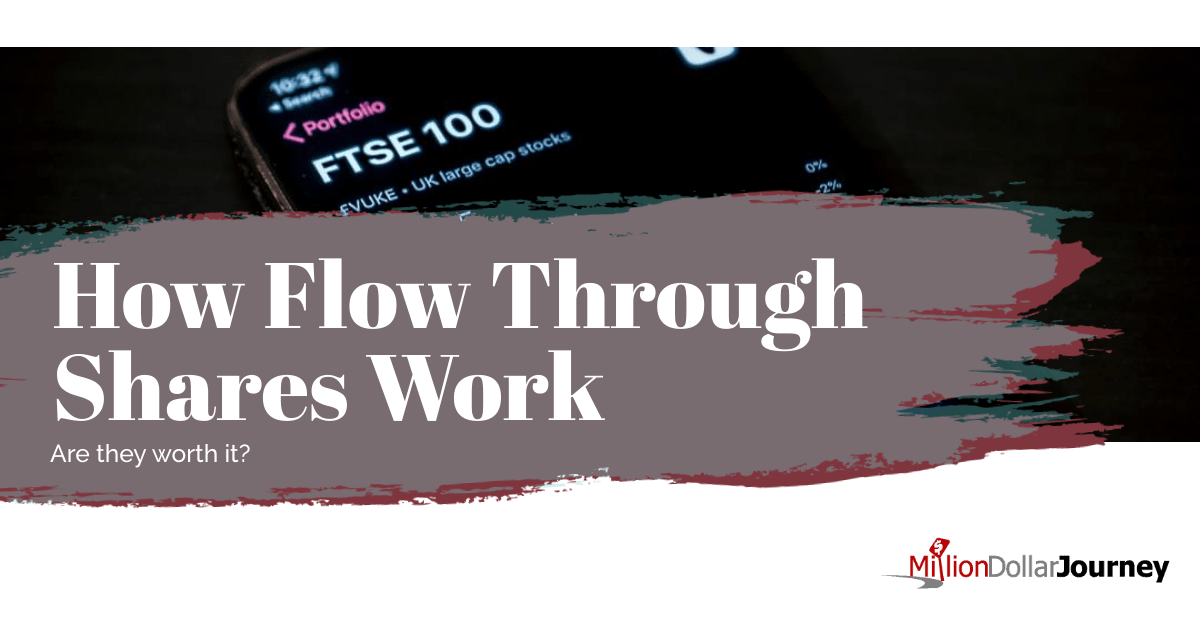Investing in Flow Through Shares in Canada
Since writing my original “How to Buy Flow Through Shares in Canada” article over a decade ago, I’m consistently surprised at how many people are interested in this uniquely Canadian investment idea.
Early on in my Million Dollar Journey, I’d written about not what flow through shares were, but also on my personal experiences, as well as the overall tax benefits of flow through shares.
Beginning a couple of years ago I decided to combine all of my flow through shares articles into one ultimate guide and then focus on keeping it updated.
My 2023 takeaway for flow through share investing is that it’s really only relevant for folks who:
- Are in high tax brackets.
- Have a thorough understanding of various investment classes.
- Have significant investing experience (and consequently more data to define their personal risk tolerance.
- Wish to donate to charity in a very tax-efficient manner.
For the rest of us the tax benefits of flow through shares in Canada aren’t enough to offset the increased risk exposure (especially if you still have room in your RRSP or TFSA).
What Are Flow Through Shares?
A flow through share (FTS) is a share that has been issued by mining, oil, gas, or energy conservation company in Canada to help finance project development. Essentially, by using flow through shares, the corporation is able to transfer its expenses to the investor.
The reason the government and industry got together to create these unique entities is that both groups wanted to create an incentive to invest in risky resource projects.
Many of these projects will fail to produce any returns for their investors; however, the ones that succeed are often very, very successful – and are of great benefit to the broader Canadian economy. So, basically the government wants to incentivize Canadians to risk their money by giving them a significant tax break for doing so.
What Are the Tax Advantages of Flow Through Shares?
The main reason why investors might consider such risky investments is the tax benefits of flow through shares in Canada. However, it’s important to know that these tax advantages are really only relevant if you’re holding your flow through shares outside of a registered account such as an RRSP or TFSA.
Flow through shares tax benefit example: If you were to investing $10,000 in flow through shares in your non-registered investment account, and you were in a 40% tax bracket, then you would automatically trigger a $4,000 increase on your tax return (or a lessening of your tax burden if you had taxes owing that year).
How Do Flow Through Shares Work?
Anyone can invest in flow through shares, however, the corporation that issues the flow through shares must be a principal-business corporation (PBC). There needs to be a written flow through share agreement between the corporation selling the shares and the individual (or corporation) who is investing. Once everything is set, the corporation’s eligible expenses will then ‘flow through’ to the original investors.
As stated above, the investor gets to claim the FULL amount invested against their income. After a couple of years, these shares roll over to a mutual fund which you can choose to sell at any time. When you do decide to sell, the adjusted cost base (ACB) is set to $0, ie. whatever you sell it for is your PROFIT.
So, if you were to invest $10,000, and sell 2 years later for $10,000, your profit would be considered $10,000. So to calculate your capital gains, with a 40% tax rate, would be $5000 x 40% = $2000 tax payable. Even in the scenario where the shares don’t change in price, you will receive a $2000 gain ($4000 tax return – $2000 tax payable).
It should be noted that two years is the minimum holding period for flow through shares, representing a significant liquidity risk.
Note: You’ll be mailed a T5013 federal tax receipt so that you can properly claim your flow through share tax benefit each year.
Who Should Buy Flow Through Shares?
Technically speaking, anyone can buy flow-through shares. However, as the incentive is to offset your taxes, it works best for individuals who are in the highest tax brackets in Canada.
That being said, from an investing point of view, expert sources have said that flow through shares should not exceed 10%-15% of your portfolio. I personally have dabbled in flow through shares, but have decided that long-term, the juice just isn’t worth the squeeze for me; consequently, I don’t currently possess any flow through shares in my portfolio.
How Does One Buy Flow Through Shares?
Flow through shares can be purchased directly from companies offering them, through mutual fund firms, and even from your local financial advisor. (Check out our Canadian online stock broker comparison.) They tend to be sold at certain times of the year and are generally sold at a premium.
Find the best place to buy flow through shares online
View our detailed Canadian broker analysis
What are the Risks/Disadvantages of Flow Through Shares?
While flow through shares can absolutely be beneficial for your taxes, there are some risks and disadvantages associated with them as well:
- If you are experienced with the Canadian mining/oil sector, you will know that this market can be fairly volatile.
- As mentioned above, flow through shares usually sell at a premium.
- You can lose up to a certain percentage of your investment, and STILL come out even due to the tax breaks. Below is a table from QIS Capital outlining the loss limits by tax bracket:
50% tax bracket – 66% of the original investment
40% tax bracket – 75% of the original investment
30% tax bracket – 81% of the original investment
20% tax bracket – 89% of the original investment
- Flow through shares have a holding period of about 2 years which means it is impossible to get your money out before then.
Flow Through Share Example
Editor’s Note: This example is now quite far in the rearview mirror, but I thought it was illustrative of how one might approach the flow through shares market. I should also point out once again, that this is not a strategy that I recommend for the average Canadian investor.
A reader, “Chewy” has left a comment on the research that he has done in the field, and he has come up with a list of his favorite mutual funds that hold flow through investment vehicles.
To briefly summarize, here are the top 3 picks based on “Chewy’s” research:
- CMP Resource LP
- Canada Dominion Resource LP
- Mavrix Explorer LP
Below is his comment:
I too have been doing a lot of research on flow through shares. I made some interesting finds.
I created a spreadsheet and tried to compare the management, performance, and expenses of these limited partnerships (LP’s). I was able to compare the prospects of 10 LP’s that I downloaded from TD’s Webbroker Initial Offerings site.
The problem I found is that when these LP’s record their performance they always use after tax dollars. So I compared their closing net asset value per unit at the time of rollover to their original unit price. I also looked at the number of years that the LP had offerings and the number of times that net asset value per unit was greater than the original unit price.
What I found is that out of the 10 LP’s I compared, only 3 LP’s had a net asset value per unit that was greater than the original unit price before the tax deductions on an offering over offering basis. Some of them, like Sentry Select NCE LP’s only had 1 out of 17 offerings that had been positive. Creststreet LP had 2 out of 10 offerings that were positive. 2 LP’s that you might want to think twice about, before giving them your money.
There were 2 that stood out from the rest. CMP Resource LP and Canada Dominion Resource LP are by far the best when comparing performance, expenses and management. Both of these LP’s are now owned by DMP Ltd. Both are also managed by Dynamic Funds which is also owned by DMP Ltd.
CMP Resource LP has the best performance record. They had 9 out of 10 offerings that had been positive. Their offerings are normally $1,000 per unit with a minimum of $5,000 buy in, but their average asset value per unit on those 10 offerings was $1,242.74. That works out to be a 24% return on your money before taxes. I calculated their average after-tax rate of return on transfer date to be 95%.
Canada Dominion Resource LP would be my second choice based on their consistency and management. They had 11 out of 16 offerings that had been positive. They are also owned and managed by the same companies as CMP. Dynamic Funds is listed as a top performer on TD’s Webbroker Fund Selector, and they have one a number of Lipper Awards for Consistency and Performance.
My Third Choice would be Mavrix Explorer LP. They had 5 out of 9 offerings that were positive. They are in the lower half of the group in expenses.
It’s important to realize that if you are investing in one of these LP’s, you are most likely going to lose money. But with the tax deductions you may come out ahead. If you are not comfortable with the risk, then I would say, just pay your tax bill.
Never invest in something just because you are looking for a tax deduction. You should only invest in something that makes sense to you and that you have a good chance that you are going to make money.
Using Flow Through Shares to Maximize Charitable Donations
Another way to use flow through shares to your advantage is to make them work for you by maximizing your charitable donations. Financial Planner Carrey Vandenberg helped us out by explaining how this all works:
If you give to charity or church on a regular or substantial basis ($5,000 or more per year) the following is something that you should seriously consider to replace your current mode of giving, namely writing a cheque and only getting the donation tax credit. Using this strategy will still put the same amount of cash in the hands of your designated charity or church, however, it can cost you a lot less.
First, I must state at the outset that the tax savings do depend on your province of residence, your marginal tax rate, your advisor, and what investment that you ultimately use for this purpose. That will be between you and your Financial Advisor.
What I call the “Double Dip Donation Strategy” starts with the investment in a “Super Flow Through Share” offering. This can save you up to $6,180 on a minimum $10,000 investment. In other words, you are only out of pocket approximately $3,800.
Flow through shares are nothing new. They have been a huge part of the Canadian economy for over 50 years, longer than RRSP’s. However, unlike RRSP contributions you must make a flow through share investment before December 31st to have the tax deductions and credits apply to the current tax year.
If you simply want the tax savings and hold the investment for yourself then you can stop there. You will have made a $10,000 investment for a net cost of only $3,820. If you choose to take a second step and use your investment as a charitable donation you will save up to an additional $4,370. The $6,180 tax savings for investing and then $4,370 tax savings for donating.
For the donation part, however, you will have to wait for the flow through shares to convert to a mutual fund. It is at this time you can gift the shares to the charity and they can be simultaneously sold for cash by the charity.
In other words, you have received just over $10,000 back in tax savings and the charity or church you have given to has received $10,000 in cash. This of course assumes that the flow through share offering you have participated in is worth the same amount.
For a regular giver to a charitable cause or church, this is considerably better than simply donating cash which produces a total tax savings of only $4,370.
I use the “Super Flow Through Share Donation Strategy” myself and will continue to do so for years to follow or until the government changes the tax rules. Multiply the tax savings by the number of years you will have breath and we are talking potentially hundreds of thousands of dollars in extra dollars for your (or your kids).
Note: The above tax-saving figures are based on the highest tax bracket in BC ($123,000+ of taxable income). The tax savings are still very compelling at the over $70,000 taxable income level and can still be attractive for taxable incomes over $38,000.
Editor’s Note: Flow through shares are very volatile with a very high probability of decreasing in value.
Disclaimer: Carey Vandenberg is a Financial Planner with Partners In Planning Financial Services Ltd (PIPFS). The views expressed have not been endorsed by PIPFS. The information contained does not constitute an offer or solicitation to buy or sell any investment fund, security or other product or service. This is not intended to provide specific financial, investment, tax, legal or accounting advice for you, and should not be relied upon in that regard. You should not act or rely on the information without seeking the advice of a professional.
Are Flow Through Shares a Good Investment?
Ultimately, flow through shares in Canada can be a good investment, but for most the added risk of speculatively investing in small resource companies isn’t worth the tax benefit.
I’m not a flow through share expert, and it should be noted that small resource extraction companies are notoriously risky. Locking in your money for two years obviously compounds that investment risk.
These days I’m a lot more drawn to lower-risk investments such as my top Canadian dividend stock picks. But if you believe you have the inside track on Canadian resource companies, plus have significant assets in a non-registered account due to being a high-income earner, then the tax benefits Canadian flow through shares generate might make them worthy of consideration.
Find the best place to buy flow through shares online
View our detailed Canadian broker analysis
I've Completed My Million Dollar Journey. Let Me Guide You Through Yours!
Sign up below to get a copy of our free eBook: Can I Retire Yet?











Thanks for another great article! I’m doing some research in flow through shares, and may invest later in the summer when I think stock prices may go down.
Flow through shares are usually a complex subject and I’ve always had trouble understanding them. Your piece on them actually made a ton of sense. Thanks for clarifying what flow through shares are so well. I had a couple junior minor positions on the venture last year and one of them issued a news release talking all about flow through but it went right over my head. Regardless, the stock headed south in a hurry and I got out.
Is there someone who reviews the flow throughs that are available in Canada as to who has the best ROI
Are you talking about alternative minimum tax?
One thing that wasn’t discussed on the tax front that I would like some info about is Marginal Tax Rate. How does the income from the shares affect Marginal Tax Rate (ie, how aggressive are you allowed to go into FTS without setting off a marginal tax rate alarm?) Im not sure exactly how marginal tax rate works so any info would be great, thanks!
The commission, fees and premium value does not make this a viable option..
31 James — the reason they used $5,000 instead $10,000 is capital gains tax is only charge on 50% of the profit (at your full marginal rate)
You have neglected to mention a very important fact about “Flow Through Shares”. They should be called “Business Loss Flow Through Shares” but that name doesn’t look good on marketing material.
Expoloration companies spend a lot of money looking for oil, gas and minerals. They have huge expenses and no revenue unless they hit the mother load. The “investors” in flow through shares get to write off the losses the company incurs against their own income. Sure you get a $4,000 tax benefit on your $10,000 investment but only because the company has lost $10,000.
Sure once in a while an investor makes a killing on flow through shares but most people lose everything other than their $4,000 tax benefit. However, the promotors and financial advisors make money every time.
[…] return bonds, but tax efficiency requires a much more individualized solution than purchasing a flow through shares or other tax friendly […]
Sorry, I didnt get the part why you would use $5000 times 40% to calculate your payable tax? I thought the entire $10000 is profit, shouldnt you be using $10000 as your taxable income? Thanks